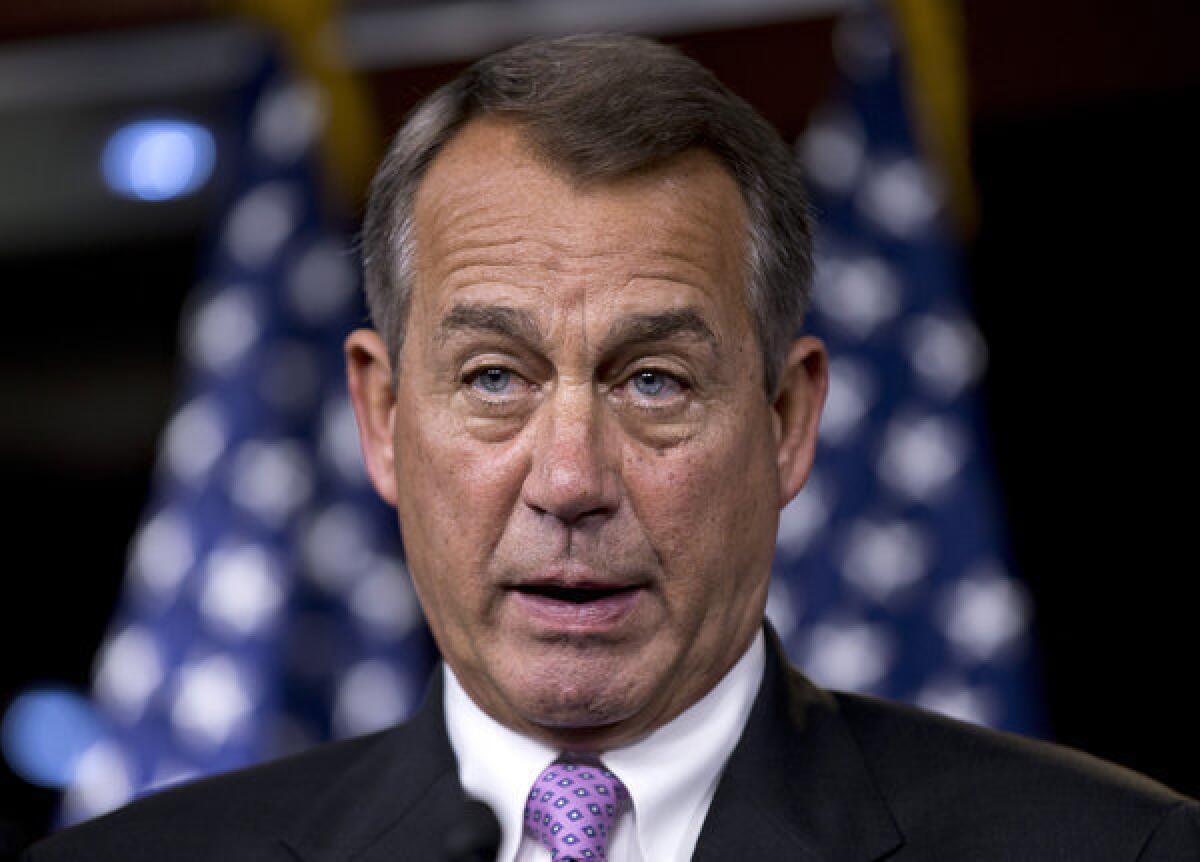U.S. is nearing its debt ceiling again, Treasury Department warns

- Share via
WASHINGTON — The nation’s debt ceiling once again looms as the spark to congressional brinkmanship that could threaten the slowly recovering economy.
The Treasury Department said Wednesday that the U.S. probably will hit its $16.4-trillion borrowing limit by the end of the year, at the same time that Congress will be grappling with the automatic tax hikes and large government spending cuts scheduled to kick in Jan. 1.
“It adds to the caldron of the dark brew,” Mark Zandi, chief economist at Moody’s Analytics, said of the fast-approaching debt limit. “That makes the disaster more disastrous.”
The Congressional Budget Office and most economists predict another recession in 2013 if the confluence of tax increases and spending reductions known as the fiscal cliff takes place.
And straying too close to the debt limit — not to mention hitting it — probably would lead to a second downgrade of the U.S. credit rating. In mid-2011, a bitter standoff over the issue led to the first credit revision.
The Treasury said Wednesday it could take “extraordinary measures” to juggle the nation’s finances to give Congress and the White House more time to work on a debt-limit increase. But even those steps — essentially a series of accounting maneuvers — would buy only into early 2013 before the government faced a possible default.
As of Tuesday, the U.S. debt was $16.165 trillion.
“I think that, as we saw last summer [2011], it’s important that the debt limit is raised in a timely manner, but really that’s in Congress’ hands,” said Matthew Rutherford, assistant Treasury secretary for financial markets.
It was the agreement then to boost the limit that created the $1.2 trillion in automatic spending cuts that are part of the fiscal cliff. The other part is the expiration of the George W. Bush-era tax cuts.
Lawmakers and President Obama will try to deal with the fiscal cliff after next week’s elections. The debt limit will probably be addressed then as well, although it has not yet been the focus of Democrats or Republicans.
House Speaker John A. Boehner (R-Ohio) said in May that he had a simple principle for raising the debt limit — any increase must be offset “by spending cuts and reforms that exceed the amount of the debt limit increase.”
“No decisions have been made on timing, but the speaker’s principle — that spending cuts and reforms must exceed any debt hike — will have to be met,” Boehner spokesman Kevin Smith said Wednesday.
A White House spokeswoman declined to comment.
Federal Reserve Chairman Ben S. Bernanke and Christine Lagarde, head of the International Monetary Fund, have warned about the negative ramifications for the U.S. and world economies if the debt limit is not raised.
But the rising limit has become a focus of conservatives, who point to it as evidence of the nation’s spiraling budget deficits.
Rep. Tim Huelskamp (R-Kan.), a Tea Party freshman, voted against the 2011 debt-limit deal because he said it didn’t cut enough government spending.
“The Treasury’s predictions are no surprise, as we have anticipated hitting the debt limit right around or before the time any actual cuts from the debt deal take effect,” he said. “Every day that goes by without a change of course in Washington is another $4 billion added to our debt. Is that the legacy we want to leave our children?”
The brinkmanship leading up to the mid-2011 debt limit increase caused Standard & Poor’s to downgrade the U.S. credit rating for the first time, to AA+ from the highest level of AAA.
The Government Accountability Office estimated recently that the delay in getting a debt-limit deal cost taxpayers an additional $1.3 billion in borrowing costs for the fiscal year that ended Sept. 30, 2011.
Part of the debt-ceiling deal provided that the automatic spending cuts — half from defense, half from domestic programs — would occur over the next decade if Congress and the White House could not agree on a broader deficit-reduction plan.
After the U.S. technically hit its then $14.3-trillion debt ceiling in May 2011, the Treasury was able to delay the effect for about 12 weeks through maneuvers such as borrowing from two federal employee pension funds.
This time, analysts estimate the Treasury would be able to make it until sometime in February.
Moody’s Investor Services, another major credit-rating company, warned in September that failure by Washington politicians to strike a deal addressing the nation’s debt problems this year probably would lead to a downgrade.
But even a deal on the fiscal cliff would not save the U.S. top-level rating Moody’s still maintains unless there was “a relatively orderly process for the increase in the statutory debt limit.”
Analyst Zandi said the fast-approaching debt limit added to the pressure in Washington to strike a major deficit-reduction deal. And any such agreement would have enough cuts to meet Boehner’s standard for a significant debt limit increase.
“There’s a sense that if we address the cliff, we address the debt ceiling as well,” Zandi said. “The timing of the debt ceiling is one reason why I think we get a deal, a big deal.”
More to Read
Inside the business of entertainment
The Wide Shot brings you news, analysis and insights on everything from streaming wars to production — and what it all means for the future.
You may occasionally receive promotional content from the Los Angeles Times.











